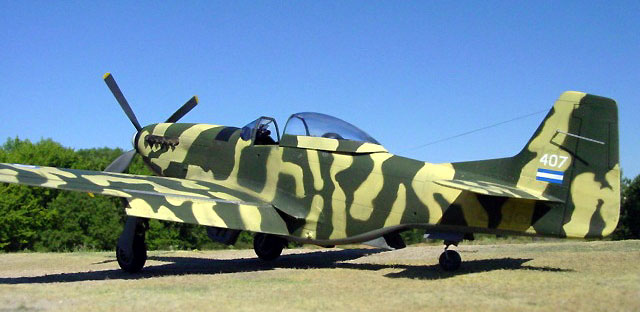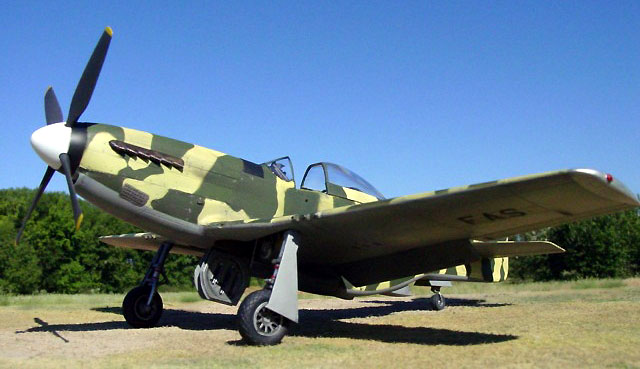|
F-51D Mustang (FAS)
by
Ian Robertson
 |
|
F-51D Mustang (FAS) |

Tamiya's 1/48
scale F-51D Mustang is available online from Squadron.com
On July 17 1969, during the 100 Hours War between El Salvador and Honduras
(also known as the "Soccer War"), F-51D Mustangs of the Salvadoran Air Force (Fuerza
Aérea Salvadoreña, or FAS) were sent to support Salvadoran ground troops at the
Honduran border. During the flight the Mustangs contacted a patrol of Honduran
F4U-5 Corsairs. In the ensuing skirmish Cap. Douglas Varela was shot down and
killed in his F-51 Mustang (#407) by Maj. Fernando Soto Henríquez. I chose to
depict the Mustang that Maj. Henríquez shot down. Decals and markings for this
aircraft are produced by Aztec Decals (Latin American Mustangs I, sheet 48-014).

Note: Maj. Henríquez' corsair was the recent subject of a
feature article on
Hyperscale by David Aungst, as well as a
photo essay by
Floyd Werner.
|
Modifying Tamiya's
1/48 Scale F-51D |
The Aztec Decal instructions outline two minor cockpit modifications for
converting a standard F-51D Mustang into one used by the FAS.
First, the back of the pilot's seat and the head rest were discarded and
replaced with a simple tubular framework made from plastic rod. Second, the
radio behind the pilot's seat was removed and replaced with a bare bulkhead and
floor made from plasticard. The area behind the seat was painted scale black;
the cockpit was painted US interior green.

The decal instructions also show an antenna on either side of the aircraft's
tail. I used three pieces to make the antenna. A central post of syringe tubing
was inserted through the tail, and on either side of the tail a piece of
stretched sprue was bent into the proper shape and then inserted and glued into
the syringe tube. The antenna was painted aluminum.
|
Paint, Decals and
Details |
 Polly
Scale Acrylics were used in painting except for the metallic colors. Three main
colors were used: (1) neutral gray for the undersurfaces and (2) yellowish-sand
and (3) dark green for the upper surfaces. For the yellowish-sand color the
decal instructions call for FS 33531 - something I could not find a match for. I
opted to mix my own color using 5 parts French Beige (FS 33564) to 2 parts
Italian Camouflage Yellow (FS 33481). The dark green used was RAF Dark Green (FS
34079) with a touch of Italian Dark Olive. Polly
Scale Acrylics were used in painting except for the metallic colors. Three main
colors were used: (1) neutral gray for the undersurfaces and (2) yellowish-sand
and (3) dark green for the upper surfaces. For the yellowish-sand color the
decal instructions call for FS 33531 - something I could not find a match for. I
opted to mix my own color using 5 parts French Beige (FS 33564) to 2 parts
Italian Camouflage Yellow (FS 33481). The dark green used was RAF Dark Green (FS
34079) with a touch of Italian Dark Olive.
The complex camouflage scheme on this aircraft presented a challenge.
I balked at the thought of using paper masks and tiny pieces of rolled up
tape. Freehand spraying was out of the question because I wanted a tight edge to
the demarcation between colors. My solution was to use UHU Tac, a removable
adhesive putty found in craft stores, as a masking agent. The UHU Tac was shaped
by hand and applied to the model once the yellowish-sand base color had dried
thoroughly. Dark green was then sprayed over the model. The UHU Tac was easy to
remove and did not leave a residue on the model's surface.

The markings on this aircraft were minimal (8 decals in total*no stencils were
added). Aztec's decals are thin and perfectly in register, although the white
areas are not completely opaque when applied to the high contrast camouflage on
the model.
An additional modification I made to the kit involved the tail wheel. Tamiya's
Mustangs have a tail wheel molded in a single piece. As such, the wheel does not
sit freely from the strut mechanism. I decided to modify the kit part slightly
by removing the wheel from its strut and then reattaching it with a piece of
wire. The wire was bent with pliers and attached to the wheel and strut using CA
glue.
If you want to build an P-51 Mustang in an unusual paint scheme, Aztec offers
a variety of striking schemes which include aircraft from the air forces of
Guatemala, El Salvador, Uruguay, and the Dominican Republic.
Click the thumbnails below to view
larger images:
Model, Images and
Article Copyright © 2002 by Ian
Robertson
Page Created 11 July 2002
Last updated 04 June 2007
Back to HyperScale
Main Page
Back to
Features Page |
Home
| What's New |
Features |
Gallery |
Reviews |
Reference |
Forum |
Search